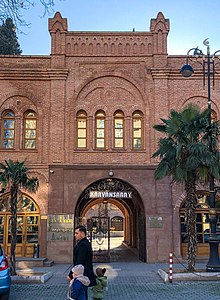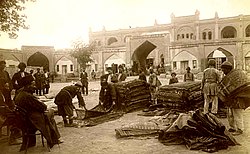
Ganja is Azerbaijan's third largest city, with a population of around 335,600. The city has been a historic and cultural center throughout most of its existence. It was the capital of the Ganja Khanate until 1804; after Qajar Iran ceded it to the Russian Empire following the Treaty of Gulistan in 1813, it became part of the administrative divisions of the Georgia Governorate, Georgia-Imeretia Governorate, Tiflis Governorate, and Elizavetpol Governorate. Following the dissolution of the Russian Empire and the Transcaucasian Democratic Federative Republic, it became a part of the Azerbaijan Democratic Republic, followed by Azerbaijan SSR, and, since 1991, the Republic of Azerbaijan.
Yengicə is a village and municipality in the Sharur District of Nakhchivan, Azerbaijan. It is located 2 km south-west from the district center, on the Sharur plain. Its population is busy with gardening and farming. There are secondary school, music school, cultural house, kindergarten, flour mill, two mosques and a medical center in the village. It has a population of 3,840. The monument was erected in honor of its compatriots who died in The Great Patriotic War. And also there is a bust of National Hero of Azerbaijan Sayavush Hasanov which was born in this village.

Juma Mosque of Ganja or Friday Mosque of Ganja is a mosque located in the centre of Ganja, Azerbaijan. The mosque was built in 1606, according to a project of Sheykh Baheddin Mohammad Amili. The mosque is also often called “Shah Abbas Mosque” because it was built on the instructions of Shah Abbas the Great during his reign.

Imamzadeh Mausoleum or Goy Imam Mosque is located 7 km northward to Ganja. It consists of a complex including walls with entrances, small mosques and funerary monuments. The mausoleum, located inside the mosque, bears the grave of Imamzadeh Ibrahim, son of Imam Muhammad al-Baqir, the fifth Imam of Shi'a Muslims.

Ganja State History-Ethnography Museum named after Nizami Ganjavi is the largest museum in Ganja,

Chokak Hamam is a historical bath near Juma Mosque in Ganja.
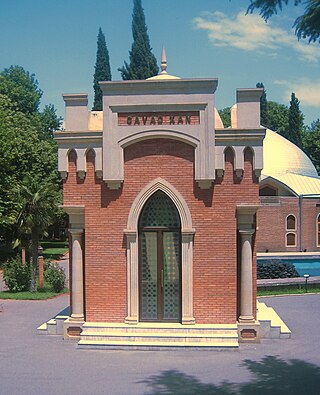
Javad Khan's tomb is in Ganja, Shah Abbas Square, near the Shah Abbas Mosque.
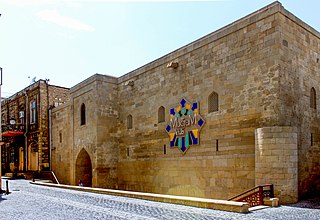
Two-storeyed caravanserai or Gasim bey caravanserai is a historic monument of the XV century. It is a part of Old City and located on Hagigat Rzayeva street, in the city of Baku, in Azerbaijan. The building was also registered as a national architectural monument by the decision of the Cabinet of Ministers of the Republic of Azerbaijan dated August 2, 2001, No. 132.
Mahsati Ganjavi Center is a center dedicated to the Persian poet Mahsati Ganjavi. The center is located in Ganja. It was built with the support of the Heydar Aliyev Foundation.
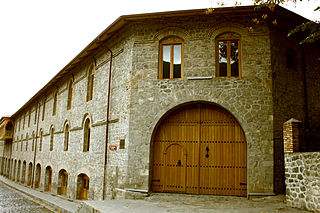
Ashaghy caravanserai or Lower Caravanserai is a historical monument of the 17th century located in Azerbaijan, in the city of Sheki.

The Shah Abbas Mosque in Keshla is a historical mosque in the Keshla settlement of the Nizami district of Baku. The mosque of Keshla village is a monument of the 17th century and was built by the order of Shah Abbas.
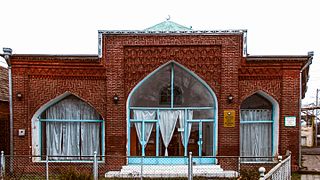
The Ozan Mosque -( Azerbaijani Ozan məscidi ) is a historical and architectural monument of the 19th century located in the city of Ganja, Azerbaijan. Ozan Mosque was built in Ganja in 1884.

The Huseynia Mosque or the Tat Mosque is a historical and architectural monument of the 19th century located in the city of Ganja, Azerbaijan.
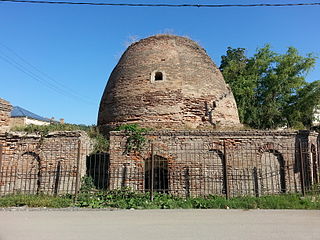
The dome bath or Gumbezli - is a historical monument in the Guba region of Azerbaijan.

Two-Storeyed Caravanserai is a caravanserai built in Shusha in the 19th century. It is a two-storeyed hotel-style caravanserai in the Sheytan Bazaar part of Shusha.
Caravansary of Safarov brothers is a caravansary built in Shusha in the 19th century. It is located in Khoja Marjanlı neighborhood. The monument, which belongs to the 19th century, is considered a republican architectural monument of the Republic of Azerbaijan. After the occupation of the city of Shusha by the Armenian armed forces, the building of the caravanserai was destroyed. Currently, its ruins remain.
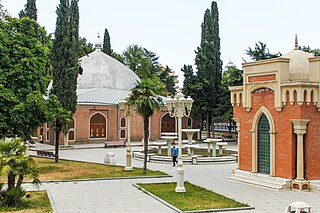
Shah Abbas Square is a square located in the historical center of the city of Ganja, Azerbaijan. At one time, it was the main memorial complex of the suburb of the Ganja fortress. The complex of Shah Abbas Square was firstly mentioned in the plan of the Ganja fortress of 1797. This architectural ensemble, located in the center of the suburb, consisted of a mosque, a bathhouse and other buildings.
Yengija bath is a historical architectural monument located in Yengija village of Sharur region.
